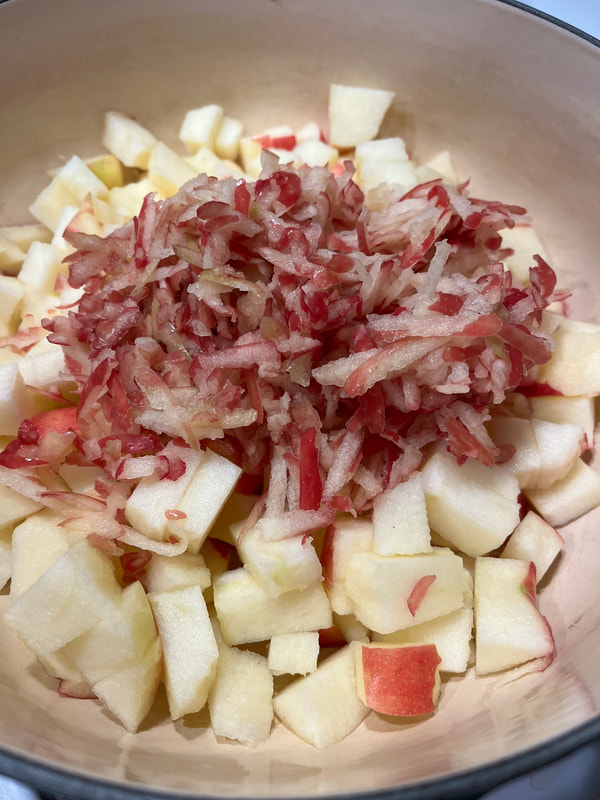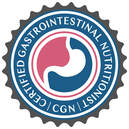|
Although you have probably tried many butternut, delicata, and spaghetti squash recipes, you likely haven't tried this winter squash variety yet. Kuri squash is by far my favorite choice for soups because it delivers this beautiful bright orange, creamy soup, that other squash varieties just can't meet. Plus, this soup is rich in fiber and polyphenols because you can eat the peel of the squash unlike many other squash varieties. You can find Kuri Squash at your local grocery store or Farmer's Market. Kuri squash also tastes great as an alternative for pumpkin pie. Since this soup is low in protein, I highly recommend pairing it with a protein rich food. For example a salad topped with grilled chicken breast or burger patty, a tuna sandwich, or simply cut in some leftover cooked protein when reheating a serving.
Coconut Ginger Red Kuri Soup INGREDIENTS 1 small Red Kuri squash 1 medium yellow onion 1 medium apple 2 inches ginger root 4 cloves garlic 1 tablespoon olive oil 1/4 teaspoon sea salt 1 can organic coconut milk 2 teaspoons Better than Bouillon Organic Vegetable paste Juice of 1/2 to 1 lemon Fresh ground pepper to taste Optional: chili flakes DIRECTIONS Cut the kuri squash in half and remove the seeds. Then cut into quarters. Steam the squash in a steamer basket over medium heat until tender when pierced with a fork, about 15-20 minutes. Allow to cool enough to handle. Chop into chunks. Meanwhile, prepare the remaining ingredients. Peel the onion and dice. Chop the apple into chunks, leaving the skin on. Peel and dice the ginger root and garlic cloves. In a large soup pot, heat olive oil over medium heat. Once hot add the prepared veggies, reduce heat to medium low, stir in 1/4 teaspoon sea salt, and saute until onions are glassy. Then pour in the can of coconut milk. Fill up the empty can of coconut milk with water and add that to the veggies as well. Add the Better than Bouillon, and add the coarsely chopped kuri squash and stir to combine. Increase heat to medium high and bring the soup to a simmer. Reduce heat to medium low and simmer for ~10 minutes. Then remove from heat and puree with an immersion blender. Add fresh ground pepper and lemon juice to taste, starting with the juice of 1/2 lemon and increasing to taste. Season with additional salt and chili flakes if desired.
0 Comments
Homemade Applesauce with a Special Twist
Most people peel their apples when making applesauce to keep the texture nice and smooth. But in the process they are discarding the most nutritious part! The apple peel is rich in gut loving and anti-inflammatory polyphenols including well known quercetin. Quercetin is most well known for inhibiting the production and release of histamine, thereby reducing the severity of seasonal allergies and other histamine related symptoms. The peel is also an excellent source of pectin a soluble fiber which can soothe the GI tract and can be especially helpful when struggling with diarrhea. Pectin is also fermented by good gut microbes and therefore helps support a healthy and diverse gut microbiome. Since we are keeping the peel on for this applesauce, it becomes increasingly important to choose ORGANIC apples, as conventional apples are highly sprayed with pesticides. And to help improve texture of applesauce, I recommend grating the apple peels instead of just coarsely chopping the apples. Although this is an extra step, it allows the apple peel to easily dissolve during the cooking process, leaving the texture more smooth. With the addition of the skin, and the increase in polyphenols and pectin, the applesauce is pinker in color and is thicker in texture. However, apples are rich in fructose and sorbitol, two kinds of sugars that are considered FODMAPs. If you don't tolerate either of these well, then applesauce (and apples) may trigger uncomfortable digestive symptoms until the underlying cause is addressed, such as SIBO (small intestinal bacterial overgrowth), which can lead to fructose malabsorption. Some people unfortunately, struggle with hereditary fructose intolerance, and will have to limit fructose entirely to avoid uncomfortable symptoms. Applesauce INGREDIENTS Organic apples Filtered water Lemon juice Spices (fresh ginger root, cinnamon, vanilla, etc) Sea salt Sweetener of choice (optional) - depending on the type of apple you may need more of less DIRECTIONS Wash your apples and grate the peels. Cut out the core and dice up the remaining apple flesh. Add the grated peels, apple bits, water, lemon juice, and your choice of spices to a large pot, cover, and bring to a simmer. Simmer until tender, about 15-20 minutes depending on the size of the chunks. Remove lid, and mash with a potato masher or whisk, stir in salt, and optional sweetener to taste. You may continue to simmer uncovered for a couple of minutes to evaporate excess water if needed until desired texture is achieved. Transfer to a sealable glass jar and enjoy. I love it with Nancy’s whole milk yogurt or cottage cheese. Show me your applesauce making skills!! Kale salads are often less than desirable. IMO. The kale leaves are either left too big and floppy, or it feels like you are a horse, chewing, and chewing, and chewing. Am I right? Well, welcome the massaged kale salad! By simply massaging kale leaves with sea salt, the friction gently breaks down the fibers, leaving the leaves more tender and easier to digest. Massaging also enhances the flavor of the kale, especially when tossed with a bunch of delicious goodies. Cooked cruciferous vegetables are often better tolerated as the heat breaks down fibers. Massaging the greens has a similar effect, while keeping intact heat sensitive nutrients. Unfortunately, I know a lot of people struggle with gas and bloating after eating raw cruciferous vegetables (kale, broccoli, cauliflower, cabbage, Brussel sprouts, etc). This is likely due to their high amounts of raffinose, a short chain carbohydrate that humans cannot digest, leaving a feast for gut bacteria. Cauliflower and Brussel sprouts are considered high FODMAP foods, and are often triggers for patients with IBS. Also, sometimes individuals do not tolerate cruciferous vegetables due to an abundance of sulfur reducing bacteria in the gut that like to feed off of their sulfur rich compounds. If you have struggled with severe foul smelling gas and bloating after eating cruciferous vegetables (or garlic and onion), you may want to consider hydrogen sulfide SIBO (small intestinal bacterial overgrowth) or LIBO (large intestinal bacterial overgrowth). However, if you tolerate cruciferous vegetables just fine, then they are a great addition to support liver detoxification and hormone health. Eating one serving of cruciferous vegetables per day, is a great dietary practice for overall health and wellness. Festive Massaged Kale Salad INGREDIENTS 1 bunch green curly kale (~8 leaves) 1/4 teaspoon sea salt 1 ½ tablespoons unrefined cold-press extra virgin olive oil 1 ½ tablespoons balsamic vinegar (white or brown) 1/3 cup coarsely chopped roasted maple almonds or walnuts (see below for recipe) **Crumbled gorgonzola, feta, or goat cheese **Dried cranberries, raisins, or currants, chopped Zest of 1 lemon (optional) Squeeze of fresh lemon juice Sea salt and fresh pepper to taste DIRECTIONS Wash your kale and shake off any excess water. You can also shake them in a clean kitchen towel. Devein each kale leaf by pulling down along the stem towards the tip of the leaf. Chop the leaves into bite sized pieces and toss into a large bowl. Add the sea salt and gently massage the kale for about 1 minute or until the kale leaves begin to break down and look shiny. Do not over massage otherwise it will wilt too much. Add the olive oil and the vinegar and toss well. Finally, add the chopped almonds, cheese, and dried fruit of your choice, and mix until combined. **Add as much of the cheese and dried fruit as you like. Add the lemon juice and lemon zest if desired. Season with salt and pepper to taste. Variation: You can swap the cheese with diced avocado. Roasted Maple Almonds Makes 1 cup INGREDIENTS 1 cup almonds (or walnuts/pecans) 1 tablespoons butter or ghee 1 tablespoon maple syrup Generous pinch sea salt DIRECTIONS Preheat oven to 350 degrees. Place almonds onto a baking sheet and roast for about 8 minutes or until fragrant. Make sure to watch that they do not burn. Set aside to cool. Heat a cast-iron pan over medium. Add the butter and the maple syrup. Stir the mixture until it bubbles a lot, becomes syrupy, and reduces in amount. Add cooled nuts and pinch of salt. Mix well to coat. Be careful as the syrup is extremely hot. With a spoon or spatula spread almonds onto a plate and allow to cool. Break into pieces. Serve with the massaged kale salad or eat as a snack! Are you kale lover? Let me know if the comments below!
Eat Happy, Selva |
RecipesI hope you enjoy my creative, flavorful, and nutrient dense approach to whole foods cooking. All recipes are gluten free. Archives
December 2022
Categories
All
|





 RSS Feed
RSS Feed


